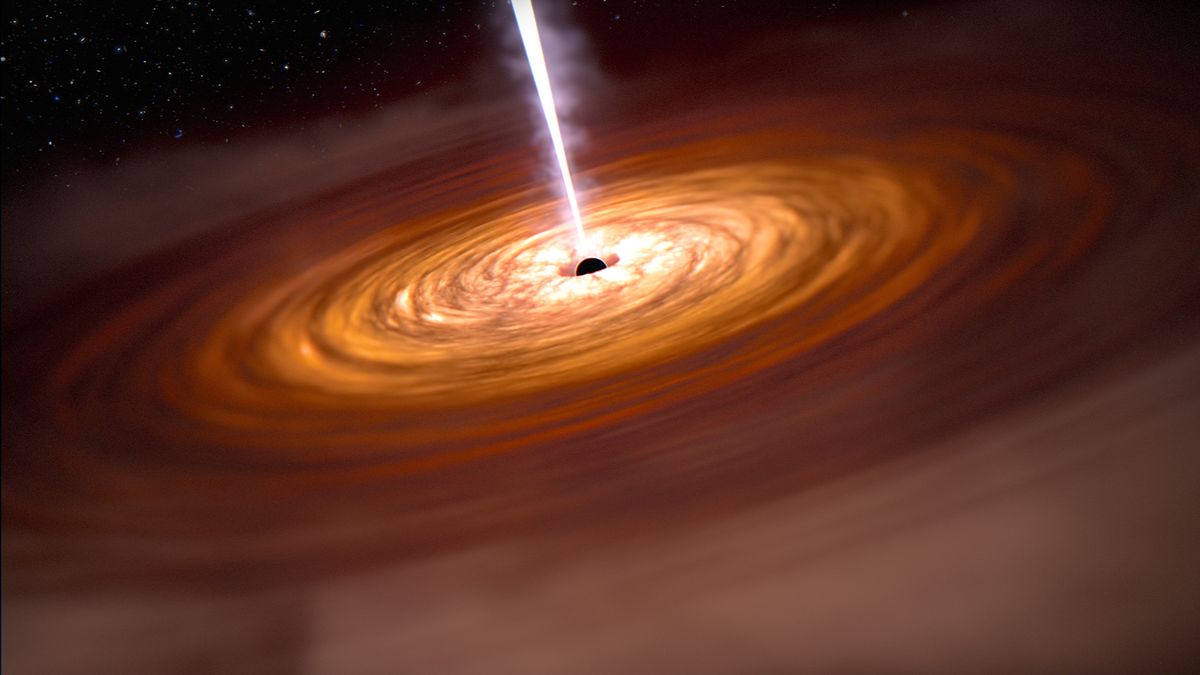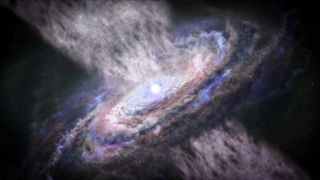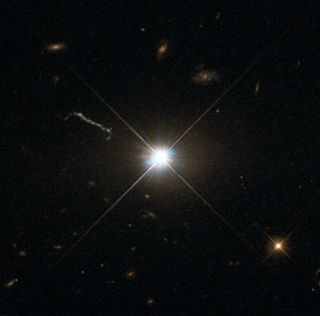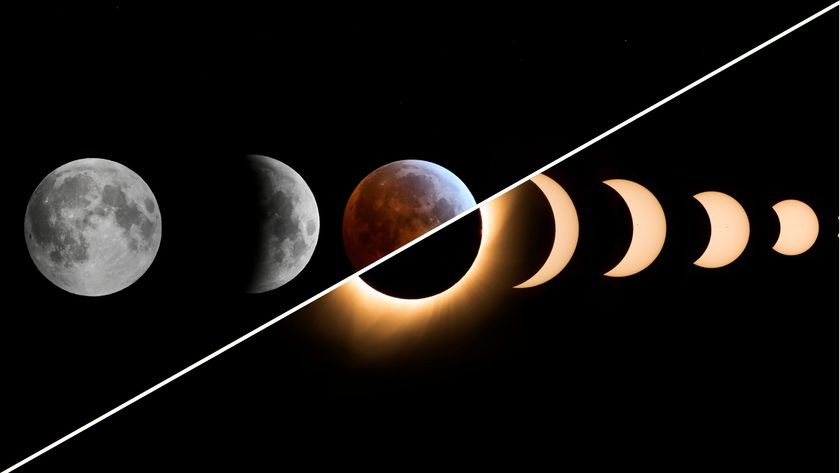Quasars: Everything you need to know about the brightest objects in the universe
Quasars are the blazing centers of active galaxies and are powered by a supermassive black hole feeding on humungous quantities of gas.

Quasars are the remarkably bright cores of active galaxies in the distant universe, they are an extreme form of what astronomers call "active galactic nuclei", or AGN for short.
An active galaxy is one in which the central supermassive black hole is consuming large amounts of matter. The infall of matter into the black hole is so great that all the material can't enter the black hole at the same time and so it forms a queue as a spiraling accretion disk.
The matter — in the form of huge clouds — falls into the disk, with the inner parts of the cloud closer to the black hole orbiting faster than the outer parts (just like planets closer to the sun orbit faster than those farther away). This creates a shear force that twists the clouds, causing them to bump into their neighbors as they move around the black hole at velocities ranging from 10% of the speed of light up to over 80%. This friction from fast-moving gas clouds generates heat, and the disk becomes so hot — millions of degrees — that it shines brightly.
Some of the material in the disk is also funneled away from the black hole in a highly luminous, magnetically collimated jet. The hot accretion disk and the jet combine to make the nucleus of the active galaxy shine so bright that it can be seen far across the universe.
Related: James Webb Space Telescope sees 1st starlight from ancient quasars in groundbreaking discovery
Quasar FAQs
Is a quasar just a black hole?
Yes, a quasar is just a black hole, but not any black hole — it is a supermassive black hole that is growing rapidly by gorging on huge amounts of gas. It is this gas, in the form of a spiraling "accretion disk" around the black hole, that becomes very hot and emits all the light. The disk, along with the spin of the black hole and the magnetic fields entwined between the two, is the source of the jet that also gives quasars much of their brightness.
How are quasars formed?
Quasars are formed when an event causes a huge amount of gas to pile onto the central supermassive black hole in a galaxy. Early in the history of the universe, this may have been streams of material flowing onto the galaxy via filaments in the cosmic web; later on, the gravitational tidal forces resulting from galaxy collisions and close encounters may have also caused some quasars to light up.
Has a quasar ever been seen?
Yes! The closest, brightest quasar — called 3C 273 — is even visible to amateur astronomers with at least an 8-inch telescope, or astro-imagers, as it shines at magnitude 12.9 in the constellation of Virgo. Quasars are so bright that they can be seen at vast distances across the universe; the most distant known quasar is seen as it appeared 13.13 billion years ago. The Hubble Space Telescope has also imaged the fainter host galaxies of quasars, so astronomers know for sure that quasars are the active cores of some galaxies.
How bright are quasars?

To give some idea of the luminosity of a quasar, scientists at the Mullard Space Science Laboratory at University College London describe how the nearest quasar, 3C 272, has a luminosity of 2.5 x 1040 watts, equivalent to 25 trillion times the luminosity of our sun. Astronomers at Ohio State University put it another way, describing how quasars can shine between 10 and 100,000 times brighter than our entire Milky Way galaxy.
How large are quasars?
Despite their incredible luminosity, the power source of a quasar is relatively tiny compared to the host galaxy it resides in. Astronomers can watch a quasar's light fluctuate because since a quasar is quite small, light can cross from one side of the accretion disk to the other in a short period of time. For the smallest quasars, it can take light just a few days to cross from one side or another. In this case, this would equate to less than 1,000 astronomical units (an astronomical unit is the distance between Earth and the sun, which is approximately 93 million miles or 150 million kilometers) in diameter. This would be the size of the black hole and its accretion disk. The more massive the black hole, the larger the accretion disk. The biggest might reach a couple of light-years in size.
This is a huge size in human terms, but compared to the size of a galaxy (our Milky Way galaxy is approximately 100,000 light-years, which is about 588 quadrillion miles (946 quadrillion kilometers) in diameter a quasar is very small and yet still produces huge amounts of energy.
How do quasars form?
What causes large amounts of matter to head toward a supermassive black hole and "activate" it as a quasar?
One scenario is a galaxy merger. When two galaxies crash into one another, the disruption caused by their respective gravitational fields shifts the direction of motion of giant clouds of molecular gas in those galaxies, causing them to fall toward the black hole.
How, though, did quasars begin life in the early universe, when there seemingly hadn't been enough time to form supermassive black holes? According to physicists at the University of Portsmouth in the UK, the black holes got a head start. Supercomputer simulations show how, within just a few hundred million years after the Big Bang, vast streams of cold gas were able to flow together forming a dynamically unstable cloud that collapsed under gravity to form primordial stars with tens of thousands of times the mass of the sun. If the model is correct, then these stars would have swiftly collapsed further, forming intermediate-mass black holes that acted as the seeds that grew into the supermassive black holes that power quasars.
How did quasars get their name?

Even though the AGN in a quasar is quite small, it shines brighter than the rest of its host galaxy. Because they are small, an AGN appears point-like from a distance. When quasars were first discovered in the early 1960s, they looked like stars at first glance because only the AGN was bright enough to be seen — the host galaxy of the quasars was too faint. As a result, the name "quasar" is a portmanteau of a "quasi-stellar" object.
Although they have similar-sounding names, quasars are not related to pulsars, which are spinning neutron stars.
How far away are quasars?

The closest quasar is 2.3 billion light-years away. Many are seen when the universe was just three or four billion years old, in an era when galaxies were closer together, encounters and collisions were more frequent and there was a larger supply of gas to feed a black hole. Among the most distant quasars is one called J0313-1806, which we see as it existed when the universe was just 670 million years old, which equates to 13.13 billion years ago.
Quasar feedback
All the radiation pouring out from a quasar can have dramatic effects on a quasar's host galaxy. Astronomers call this "feedback", and critical to the feedback effect are powerful outflows of ionized gas blown from the quasar by radiation winds that are akin to the solar wind, but many times more powerful.
The consequences of these outflows can often be contradictory. On the one hand, as they expand out into the host galaxy at large, they push molecular gas clouds together, triggering gigantic starbursts — periods of rapid star formation. On the other hand, the outflows can blow away the gas from the interstellar medium, either heating it enough that it becomes too energetic to collapse to form stars, or expelling it from the galaxy entirely, therefore starving star formation of its fuel. The effects of the outflows from quasars can have long-lasting consequences for the evolution of galaxies, often bringing their star-forming phase to a halt after a brief burst, sometimes for hundreds of millions of years, sometimes forever.
Are there other types of AGN?
There is an entire spectrum of AGN, emitting different amounts of energy. Quasars are near the extreme high end of this spectrum, but there are other types of AGN that are not quasars.
Consider that quasars are so bright because they are almost facing head-on to us. When they do face exactly head-on, and we are looking down the beam of their relativistic jet, we call them a blazar, because their jet appears much brighter and appears to be 'blazing'. One notable type of blazar is a "BL Lac" object, which is seen to vary dramatically in brightness and has a bland spectrum with few if any obvious spectral lines.
There are other types of AGN. Seyfert galaxies have an accretion disk but no bright jet and generally weaker activity than a quasar. They can be split into two different classes, which are the same type of object just seen at different angles. Seyfert Type I AGN are notable because they have two strong sets of spectral lines in their spectrum, broad and narrow, whereas Seyfert Type II AGN do not have strong broad emission lines. This is because we are seeing them from different angles: in Type I Seyferts, we are looking straight down onto the accretion disk, but in Type II we are looking more edge-on, where some of the emission is blocked by a thick torus of dust.
At the opposite extreme to quasars and blazars are LINERs, which stands for Low Ionization Nuclear Emission-line Regions. LINERS have weak AGN activity; some might not even have an accretion disk and therefore would not be true AGN.
All AGN can also divided into two camps — those that emit lots of radio waves (so-called "radio-loud galaxies") and those that do not. This division can be split across the same type of AGN — for example, some quasars are radio-loud such as 3C 273, which was first identified in the 1950s as the 273rd object in the Third Cambridge catalog of radio sources, while other quasars are radio-quiet.
Quasar expert Q&A
We spoke to Dr Vicky Fawcett of the University of Newcastle about her research studying the so-called red quasars, whose light has been reddened by cosmic dust and which also tend to have strong radio emissions.

Vicky Fawcett studies red quasars, whose light has been reddened by cosmic dust and which also tend to have strong radio emissions.
At what redshift do we tend to find quasars at, and where do the red quasars fit into this?
We find quasars at all redshifts, although the peak quasar activity was around redshifts 2 to 3 (approximately two to three billion years after the Big Bang). We broadly expect red quasars to live alongside normal quasars, but if we do believe that red quasars are in a younger phase than blue quasars, then we might expect them to be more common, on average, in the early universe (i.e., at higher redshifts).
However, there are statistical biases that come into play with red quasars, since the dust will make the light from the red quasars dimmer than a blue quasar with the same intrinsic brightness. Therefore, your observations will be biased towards brighter red quasars and so it is difficult to compare the two populations. In our work, we actually control for both the brightness and redshift of the quasars to make sure we do include these biases in our analyses.
Where does the dust that reddens the quasar light come from?
The dust should initially have formed in stars. Where the dust that causes a quasar to be red is located generally depends on which model you believe. Some red quasar studies claim that the dust (what causes a quasar to be red) is due to a dusty torus-like structure that surrounds the accretion disk. In this model, a red and blue quasar are the same object which only differ depending on our line-of-sight: in a red quasar, our line-of-sight intercepts the dusty torus causing it to be red. Another model, which my results are in best agreement with, is the evolutionary model. This predicts that some event, such as a merger, funnels gas into the centre of the galaxy, causing a starburst phase and igniting a quasar. The quasar is initially obscured because of all the gas and dust surrounding the quasar (the red quasar phase), likely due to the starburst (although a large portion of dust could have come from interstellar space). Then, through outflows, the quasar blows away the surrounding dust, eventually revealing a blue, unobscured quasar.
Do we think our Milky Way was once a quasar?
We think that quasars (and more generally, active galaxies) will eventually run out of fuel and become an 'inactive', typical galaxy. However, quasars are usually in massive galaxies which host massive black holes at their centre. The Milky Way has a relatively small black hole in its centre so would have been unable to produce an extremely bright quasar. Saying this, the Milky Way was likely "active" in the past due to remnant jets we can observe from the central black hole, although it would have been a much less powerful active galaxy than a quasar. Eventually (in ~2 billion years), the Milky Way will merge with our neighbouring spiral galaxy, Andromeda, and form a typical quasar, which will likely go through a red quasar phase."
Additional resources
See the selection of images of quasars and assorted AGN at the website of NASA's Chandra X-ray Observatory. Learn about the discovery of quasars in Caltech's '50 Years of Quasars' story and in this paper written by Ken Kellerman of the National Radio Astronomy Observatory.
Bibliography
Dana Berry, NASA Scientific Visualization Studio, 'Black Hole Accretion Disc Energies', 2010, https://svs.gsfc.nasa.gov/10545/
G. Risaliti et al, 'A Rapidly Spinning Supermassive Black Hole at the Centre of NGC 1365', Nature, 27 February 2013, https://www.nature.com/articles/nature11938
Saibal Saha, Hunting for Exotic Galaxies: The Story of Quasars, Mullard Space Science Laboratory, UCL, 2012 https://www.mssl.ucl.ac.uk/~gbr/Project%20Website/styled-5/index.html
Barbara Rydon, 'Quasars', Ohio State University, February 2003, https://www.astronomy.ohio-state.edu/ryden.1/ast162_8/notes36.html#:~:text=Quasars%20have%20luminosities%20which%20lie,big%20galaxy%20like%20our%20own
'Introduction to Active Galaxies', The Open University, https://www.open.edu/openlearn/science-maths-technology/introduction-active-galaxies/content-section-4.2
'Quasar Discovery Sets New Distance Record', National Radio Astronomy Observatory, 12 January 2021, https://public.nrao.edu/news/quasar-new-distance-record/
D. Michael Crenshaw, Steven B. Kraemer, Ian M. George, 'Mass Loss from the Nuclei of Active Galaxies', Annual Review of Astronomy and Astrophysics, June 2003, https://www.annualreviews.org/doi/10.1146/annurev.astro.41.082801.100328
Jaejin Shin et al, 'Positive and Negative Feedback of AGN Outflows in NGC 5728', The Astrophysical Journal, 2019, https://iopscience.iop.org/article/10.3847/1538-4357/ab2e72
M. A. Latif et al, 'Turbulent Cold Flows Gave Birth to the First Quasars', Nature, 6 July 2022, https://www.nature.com/articles/s41586-022-04813-y
Join our Space Forums to keep talking space on the latest missions, night sky and more! And if you have a news tip, correction or comment, let us know at: community@space.com.
Get the Space.com Newsletter
Breaking space news, the latest updates on rocket launches, skywatching events and more!

Keith Cooper is a freelance science journalist and editor in the United Kingdom, and has a degree in physics and astrophysics from the University of Manchester. He's the author of "The Contact Paradox: Challenging Our Assumptions in the Search for Extraterrestrial Intelligence" (Bloomsbury Sigma, 2020) and has written articles on astronomy, space, physics and astrobiology for a multitude of magazines and websites.












